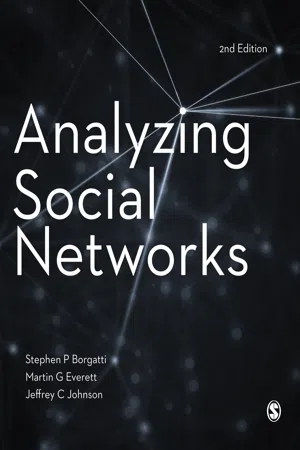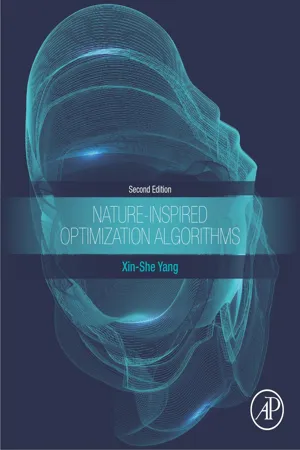Graph Algorithms
Graph algorithms are a set of techniques used to solve problems related to graphs, which are structures consisting of nodes and edges. These algorithms are used to traverse, search, and manipulate graphs to solve various computational problems. They are fundamental in computer science and are applied in diverse areas such as network routing, social network analysis, and recommendation systems.
5 Key excerpts on "Graph Algorithms"
- eBook - ePub
Bioinformatics Algorithms
Design and Implementation in Python
- Miguel Rocha, Pedro G. Ferreira(Authors)
- 2018(Publication Date)
- Academic Press(Publisher)
...Chapter 13 Graphs: Concepts and Algorithms Abstract In this chapter, we present the mathematical concept of graph and its computational representation. We address some of the main algorithms over graphs and develop a set of Python classes to implement different types of graphs and underlying algorithms. Graphs will be central in the development of algorithms for handling biological networks and genome assembly, tasks addressed in the next chapters. Keywords Graphs; Graph representations; Adjacency lists; Node degree; Paths and distances in graphs; Graph search algorithms In this chapter, we present the mathematical concept of graph and its computational representation. We address some of the main algorithms over graphs and develop a set of Python classes to implement different types of graphs and underlying algorithms. Graphs will be central in the development of algorithms for handling biological networks and genome assembly, tasks addressed in the next chapters. 13.1 Graphs: Definitions and Representations A graph can be defined, in Mathematics, as a set of objects in which some of the pairs of the objects in this set are related. While they can be easily defined and have a simple structure, they are powerful and flexible data structures, with a huge set of applications in computer science and many fields of science and engineering. Formally, a graph G can be defined by two sets: (V, E), where V is the set of objects, named as vertices or nodes of the graph, and E is a set of pairs (u. v) of vertices from V, named edges or arcs, indicating the existence of a relationship between u and v. The edges in E may have an orientation, i.e. the pairs are ordered, in which case the graph is classified as directed, or digraph. Otherwise, the pairs are unordered and the graph is termed undirected...
- eBook - ePub
- Stephen P Borgatti, Martin G Everett, Jeffrey C Johnson(Authors)
- 2018(Publication Date)
- SAGE Publications Ltd(Publisher)
...2 Mathematical Foundations Learning Outcomes Represent networks in graph-theoretic language Identify paths, walks, trails and components Formulate networks in matrix terms Compute and interpret multiplication of adjacency matrices Don’t forget to visit the website at https://study.sagepub.com/borgatti2e 2.1 Introduction As should be evident from Chapter 1, social network analysis is a social science. The actors we study are typically individuals (specifically humans, but also other social species such as apes and dolphins) or organizations (such as corporations). But networks are encountered in many other fields as well, including physics, ecology, chemistry, neurology, genetics and computer science. What these instances of network analysis have in common is an underpinning in a branch of discrete mathematics called graph theory. In this chapter we introduce the terminology and basic conceptual building blocks of graph theory. In addition, we present a short introduction to matrices, which can also be used to represent networks, and matrix algebra, which has proved very useful in network analysis. 2.2 Graphs One way of conceptualizing networks mathematically is as graphs. The term ‘graph’ here does not refer to a diagram but rather a mathematical object (Harary, 1969). A graph G (V, E) consists of a set of vertices V (also called nodes or points), and a set of edges E (or links or lines). The edges connect pairs of vertices. To express that an edge connecting vertices u and v exists in a graph G, we write (u, v) ∈ E (G). If we think of G as a binary relation, then we could also write uGv. For example, if G represents the ‘likes’ relation, the uGv would indicate that u likes v. When two vertices are joined by an edge, we say the vertices are adjacent. So, adjacent just means ‘has a tie’. If an edge connects A with B, and another edge connects A with C, we say that the two edges are incident upon A...
- eBook - ePub
The Cyber Patient
Navigating Virtual Informatics
- Rebecca Mendoza Saltiel Busch(Author)
- 2019(Publication Date)
- Productivity Press(Publisher)
...Chapter 6 Algorithms Effective algorithms make assumptions, show a bias toward a simple solution, trade off the costs of error against the cost of delay, and take chances. Brian Christian American nonfiction, science, and philosophy author Tom Griffiths Professor of Psychology and Cognitive Science at UC Berkeley and Director, Computational Cognitive Science Lab Introduction An algorithm is a constructed set of specifically defined procedures that act upon stored or input data in a specified sequence. An algorithm answers a specific question in response to a hypothesis or to generate intelligence to create a hypothesis for further analysis. The key is to ask the right question that will have a measurable impact on day-to-day health decisions. This chapter provides a fundamental overview of algorithms. These concepts have been applied among all technology platforms. Understanding Algorithms Algorithms can execute a process or build models for predictive behavioral analysis. An algorithm could be an informal set of processes or a formal, specifically defined process. Formal processes are required for algorithms managed via the use of a computer programming language that tells the computer what to do. One simple algorithm written for an insurance company’s claims adjudication system requires that, for every claim submitted, a patient be a member of the company’s insurance program. If the patient is not part of that program, then the algorithm directs the insurance company to deny the claim. An informal algorithm can be expressed using everyday language. Language coupled with the structure of grammar and use of known references can create a prescribed set of procedures. Consider the following narrative: At approximately 8 a.m. the students will arrive at school to register for the final examination. The test will begin at 9 a.m. Late arrivals will not be allowed into the examination room. The relationships in the narrative are straightforward...
- eBook - ePub
- Xin-She Yang(Author)
- 2020(Publication Date)
- Academic Press(Publisher)
...Mathematical optimization or programming is the study of such planning and design problems using mathematical tools. Since most real-world applications are often highly nonlinear, they require sophisticated optimization tools to tackle. Nowadays, computer simulations become an indispensable tool for solving such optimization problems with various efficient search algorithms. Behind any computer simulation and computational methods, there are always some algorithms at work. The basic components and the ways of they interact determine how an algorithm works and the efficiency and performance of the algorithm. This chapter introduces algorithms and analyze the essence of the algorithms. Then we discuss the general formulation of an optimization problem and describe the modern approaches in terms of swarm intelligence and bio-inspired computation. A brief history of nature-inspired algorithms is reviewed. 1.1 What Is an Algorithm? In essence, an algorithm is a step-by-step procedure of providing calculations or instructions. Many algorithms are iterative. The actual steps and procedures depend on the algorithm used and the context of interest. However, in this book, we mainly concern ourselves with the algorithms for optimization, and thus we place more emphasis on iterative procedure for constructing algorithms. For example, a simple algorithm of finding the square root of any positive number k > 0 or x, can be written as x t + 1 = 1 2 (x t + k x t), (1.1) starting from a guess solution x 0 ≠ 0, say, x 0 = 1. Here, t is the iteration counter or index, also called pseudo-time or generation counter. The above iterative equation comes from the re-arrangement of x 2 = k in the following form: x 2 = k 2 x, ⟹ x = 1 2 (x + k x). (1.2) For example, for k = 7 with x 0 = 1, we...
- eBook - ePub
Culture, Curiosity and Communication in Scientific Discovery
The Eye in Ideas
- Nigel Sanitt(Author)
- 2018(Publication Date)
- Routledge(Publisher)
...6 Graph theory Up to now I have described the network model for scientific theorizing in qualitative terms. There is, however, a branch of mathematics which deals with networks at a quantitative level called graph theory. There is an enormous range of types of networks and graph theory provides a mathematical and formal framework for describing, analysing and calculating with networks. All the procedures and characteristics of networks, which I have described, have a ready interpretation in graph theory and many results and theorems in graph theory have a corresponding application in the network model I have proposed. There are no true propositions in science but mathematics is an effective tool both as cement within scientific theories, linking assumptions and predictions, and as a logical foundation for the network structures that constitute the backbone of our understanding. 6.1 What is a graph? There are two different meanings of graph, which have arisen rather confusingly in mathematics. The more commonly known meaning of graph refers to a data plot. The usual example of this type of graph is the familiar diagram of Cartesian coordinates, which consists of two perpendicular axes designated x (horizontal) and y (upright). There are many kinds of graph other than the Cartesian coordinate graph, which was described by René Descartes in 1637. The second meaning of graph, and the one relevant to the present work, was first proposed by the Swiss mathematician Leonhard Euler in 1735. In this sense of the word, a graph is a collection of objects linked together. Pictorially, they are represented by nodes, which may or may not be linked together by lines. 1 If the links are ordered then the lines have arrows on them and are referred to as arcs and the nodes are called vertices; such a graph is said to be directed. Figures 5.1 and 5.2 in the previous chapter are examples of directed graphs or digraphs. The vertices or nodes of a graph may be labelled or unlabelled...




